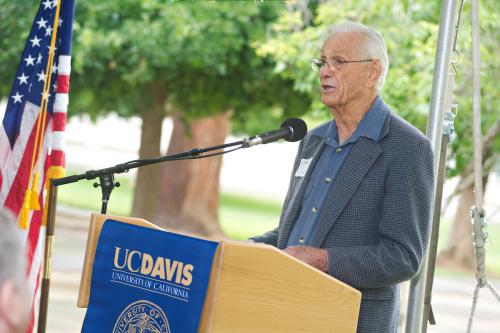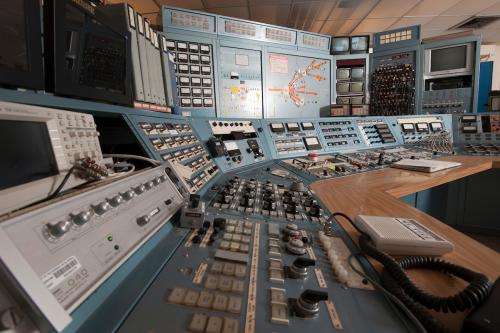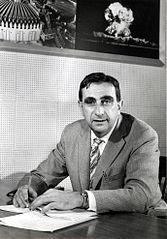Early in the movie Oppenheimer, J. Robert Oppenheimer (Cillian Murphy) visits the Berkeley laboratory where Ernest Lawrence is building a particle accelerator to study nuclear physics. The scene reminded me that the giant magnets from one of those accelerators later came to UC Davis, forming the core of the cyclotron at the Crocker Nuclear Laboratory on campus. It is one of several links between Oppenheimer, the Manhattan Project and UC Davis.
John Jungerman
In the heart of the UC Davis campus, between the physics, engineering and mathematical sciences buildings, is Jungerman Hall, which houses the Crocker Nuclear Laboratory. Completed in 1966, the building was dedicated in 2011 in honor of John A. Jungerman, professor emeritus of physics who had established the laboratory and built up UC Davis’ physics program.
As a graduate student during the Second World War, Jungerman was recruited to the Manhattan Project. He worked at the Oak Ridge laboratory for a year, training workers who were separating uranium isotopes, before being transferred to Los Alamos to work on the implosion design for an atomic bomb.
In an interview recorded in 1995, Jungerman recounted how he and a Los Alamos colleague heard “scuttlebutt” about an impending test. They drove over a 100 miles to the desert test site, slipped past guards and camped out on a cinder cone about 20 miles from the test site.
“It rained a little in the night, although nothing like the storm that’s sometimes shown,” he said. As the 5:30 a.m. time for the test came and went, Jungerman and his friend started to pack up to leave. Then, “an awesome explosion came in the predawn darkness and lit up the mountains,” he said, followed by a purple mushroom cloud.
Realizing the cloud would be full of radioactive material, they decided to “get the hell out of there,” Jungerman said.
His feelings about the test were mixed.
“There was pity for the Japanese that it would be used on, and some pride that it had worked,” he said. “I felt there was something new in the world that we would have to deal with.”
After the war, Jungerman completed his doctorate and joined the faculty at UC Davis in 1951. He retired in 1991, but returned to teach popular classes, including on arms control. Jungerman died in 2014.

The cyclotron
Jungerman and colleagues wanted to make the newly established physics department at UC Davis into a top research center for nuclear physics. They got help from Ernest Lawrence, who donated two giant magnets from a cyclotron at Berkeley. The magnets arrived on campus in 1964 on two low-loader trucks and formed the core of UC Davis’ own cyclotron. A building to house the accelerator, along with a control room and laboratories, was built around the machine, next to what was then the campus hog barn.
The UC Davis cyclotron produced its first beam in 1966 and is still in operation today. Over six decades, it has been used for a long-running project monitoring air quality in national parks, testing components for spacecraft, studying ancient documents and treating ocular cancer, as well as for nuclear physics research.

Edward Teller
Born in Hungary, Edward Teller studied quantum physics in Germany but left when the Nazis came to power in 1933, eventually reaching the U.S., where he worked with Enrico Fermi at the University of Chicago and later joined the Manhattan Project at Los Alamos.

After the war, Teller founded what is now the Lawrence Livermore National Laboratory and pursued development of the hydrogen bomb. Teller sought a graduate program that could bring young scientists to the Livermore lab, and in 1963 the graduate program, later department, in applied science was formed within the new UC Davis College of Engineering. The program provided training in nuclear physics, computational science, materials science and later, optics and lasers. Department faculty held joint appointments at LLNL and UC Davis.
Teller was evidently not easy to get on with. Chancellor Emil Mrak later described him as “a bull with steam coming out of his nose and his head down.”Abundant Harvest: The History of the University of California, Davis by A. Scheuring, 2002. Published by UC Davis History Project. He later was made a University Professor, without direct ties to the Davis campus.
Teller died in 2003. The Department of Applied Science was dissolved in 2011 and faculty were reassigned to other departments in the College of Engineering.
Media Resources
John Jungerman interviewed by Professor William Knox, 1995 (AggieVideo)
Obituary: UC Davis physicist John A. Jungerman, 92, helped develop first atomic bomb (Sacramento Bee)
In Memoriam: Edward Teller, 1908-2003 (University of California)
UC Davis Crocker Lab Celebrates 50th Anniversary (College of Letters and Science)
